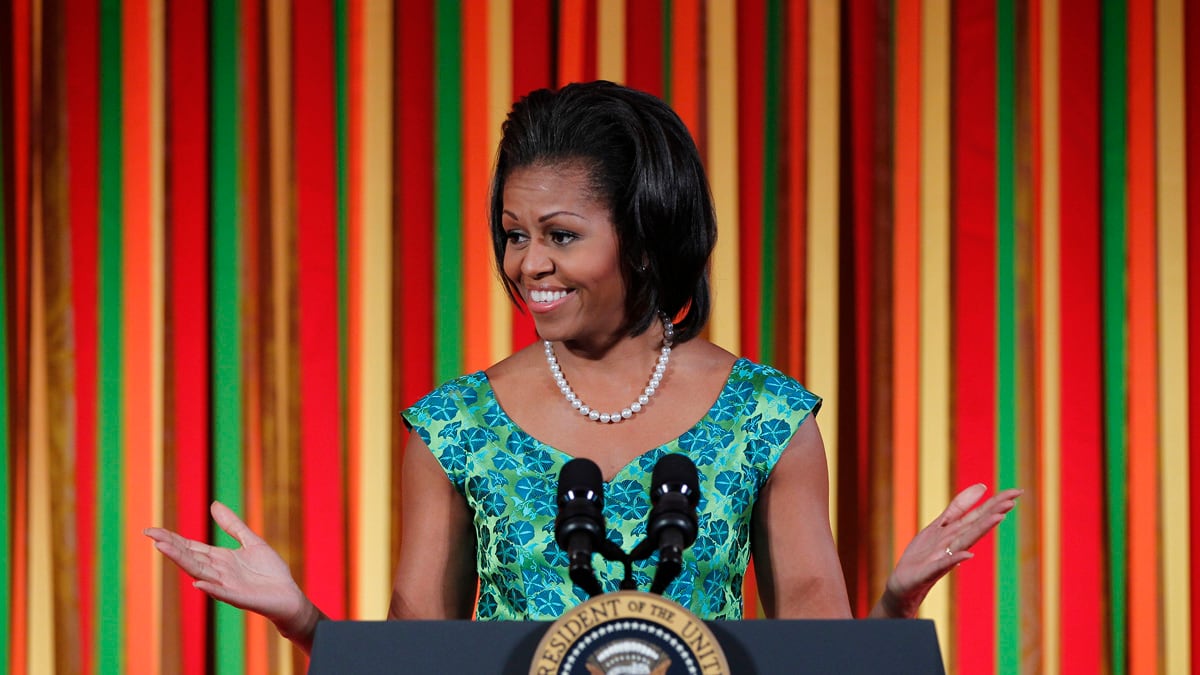
The last time Michelle Obama delivered a speech on stage at a Democratic National Convention, she wore a teal sheath by Chicago-based designer Maria Pinto, which was accessorized with a starburst brooch at the center of the neckline. Over the course of the 2008 presidential campaign, both the designer and the classic silhouette came to define Obama’s style. Her aesthetic philosophy consisted of bold colors, body-conscious cuts, personal flourishes, and a knack for understanding that fashion—used judiciously—can further a narrative.
Obama’s simple teal dress was more understated and recognizably middle class than the shimmering yellow Oscar de la Renta shirtdress with the popped collar that Cindy McCain wore to the opening night of the Republican Convention that same year. Obama’s frock reflected her boardroom background without the boss-lady overtones. It was a contemporary style but not a self-consciously fashionable one. The dress struck just the right tone for a woman charged with the complicated task of remaking her own image while also flattering her husband’s. It was a dress in service to a moment.
When Michelle Obama began the campaign, she dabbled in boisterous suits that were more about boardroom pugnacity than any sort of coherent, personal statement. The suits, often with floppy sleeves or three-quarter-length ones, eventually gave way to pearls and demure dresses that recalled Jacqueline Kennedy and the days of Camelot. Preppy jewelry and an insouciant flip to her hair softened an image that, in the political brawl, had begun to harden into a cliché: the tough, aggrieved, and “angry” black woman. The style was useful, but again, not especially personal.
The brightly colored sheath was a form of political détente and self-definition.

This time, when Obama speaks at the Democratic National Convention in Charlotte, circumstances will have changed dramatically. Pinto, whose designs received so much attention during the last presidential campaign, has shuttered her retail operation. Over time, her wardrobe has become less parochial, less earnest. It now includes the work of the industry’s finest designers, as well as the most familiar big brands. She is also now a widely admired first lady known for her signature issue: fighting childhood obesity. Her image is finely etched.
At the 2012 convention, fashion has a different role to play. Yet it is no less complicated. It must speak to the grand trappings of a now symbolic figure; but it must also evoke the just-one-of-us empathy that a campaign demands. It must dazzle without distracting.
As first lady, fashion has helped Obama shape an image that is both accessible and aspirational. She spares no expense for state dinners or other formal events. With singular creations from Naeem Khan, Tom Ford, Doo-Ri Chung, and Ralph Lauren, she has pushed American-hued glamour onto the world stage. And with day dresses from Talbots, J. Crew, and Target, fashion has helped maintain her everyday appeal.
Obama developed a visual vocabulary that signaled a change in the way modern first ladies present themselves. She is unabashed in the pleasure she finds in fashion, in her willingness to engage with its creative spirit and to support its independent entrepreneurs—folks not wholly vetted by the Washington establishment. Indeed, thus far, she has not worn—at least in public—clothes by Washington’s de facto designer-on-call Oscar de la Renta. But she has worn dresses by his son, Moises.
As has happened with first ladies who have preceded her, Obama’s style has become more polished during her time in the White House; she has become more adept at ensuring that most every photograph is a flattering one (or at least not appalling)—and that her clothes speak to the point at hand.
As first lady, Obama stopped relying on sheath dresses. She didn’t settle into a kind of uniform—as was the case with her two most recent predecessors. Instead, her style has become more daring, more far-flung—yet still driven by a particular point of view. By night it is glamorous—of the red-carpet, body-glow, Hollywood sort. By day, it is playful, feminine, and confident. But it is never a full-on expression of power—proof that she has been a close student of politics and its perils.
Certainly, there have been missteps and kerfuffles—disembarking from Air Force One wearing hiking shorts, choosing a gown from British fashion house Alexander McQueen for the China State Dinner at the White House, wearing Lanvin sneakers to a food bank.
But mostly, fashion has served as a reliable tool rather than a distraction during her tenure. While she has not attended New York fashion week—in the manner of a French first lady supporting Paris prêt-a-porter—her patronage has turned a spotlight on emerging designers. She has goosed business for more than a few brands.
Fashion has become her acknowledged hobby, similar to, although not as widely accepted as, the president’s obsession with basketball.
As for the president’s style, he has consistently displayed loose-limbed ease in a business suit. And over the years, the memory of his throwing out the first pitch at the 2009 All-Star Baseball game wearing a pair of too-short grandpa jeans has blissfully faded. In a more fashionable turnabout, his casual wardrobe, particularly on the campaign trail, has included slim-cut, flat-front khaki trousers in regular rotation.
When the president accepts his party’s nomination, he will certainly do so in an unsurprising, familiar dark suit. When Mrs. Obama speaks, her attire is likely to be familiar as well. The first lady often shops her own closet for public appearances. But it is unlikely to be banal.
In the shaping of her image and the delivery of her message, fashion isn’t the theme, but it’s an essential part of the subtext.






